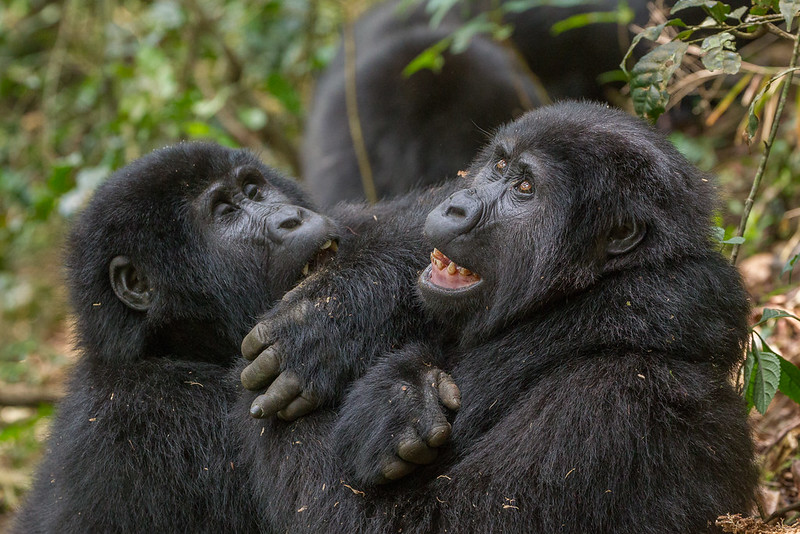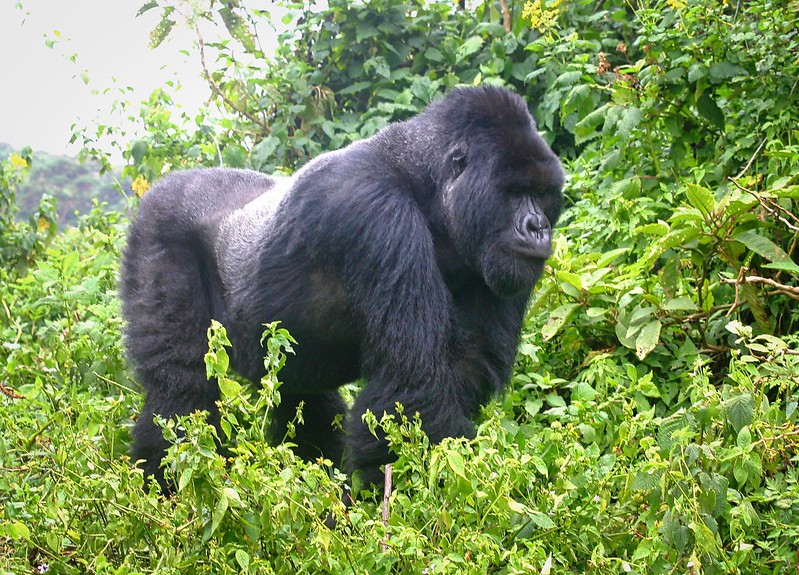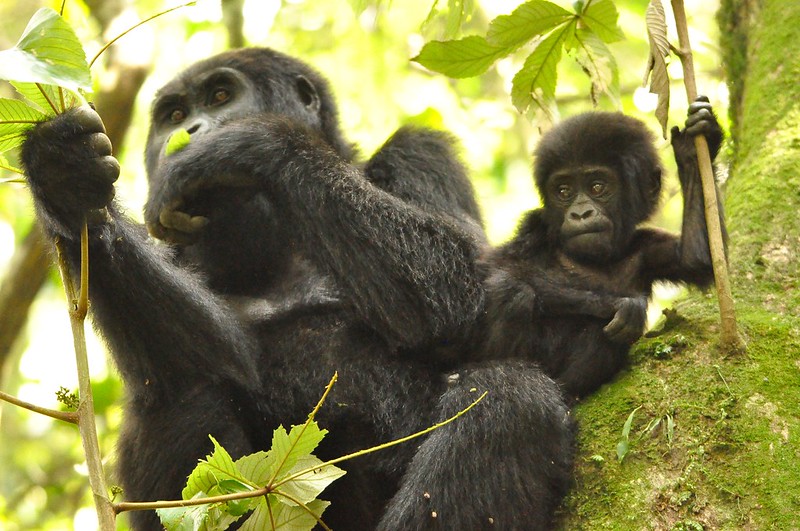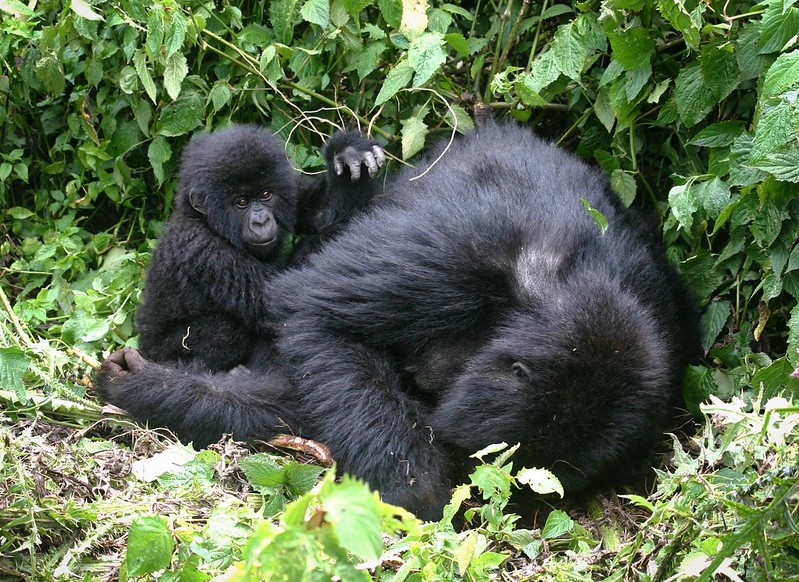Mountain gorillas in Africa
Mountain Gorillas, the largest primates, inhabit forests, wetlands, and lowland regions in East, Central, and Western Africa. Gorillas are classified into two distinct species: Eastern gorillas and Western gorillas. The Western gorillas are categorized into two subspecies: the Western lowland gorillas and the Cross River gorillas. Similarly, the Eastern gorillas are classified into two subspecies: the Mountain gorillas and the Eastern lowland gorillas. The eastern gorillas are classified into two distinct sub-species, specifically the mountain gorilla and the Eastern lowland gorilla. These sub-species are exclusively found in the Virunga mountains and Kahuzi Biega National Park, respectively. Western lowland gorillas are predominantly observed in zoological settings and are found in several regions including Equatorial Guinea, Gabon, Congo Brazzaville, Angola, Central African Republic, Cameroon, and the Democratic Republic of Congo.
Mountain gorillas in East Africa
Mountain gorillas in Africa exclusively inhabit East and central Africa, specifically Uganda, Rwanda, and the Democratic Republic of Congo. Consequently, these gorillas can only be observed in the parks that span across these three countries. These parks include the Bwindi Impenetrable Forest, Mgahinga National Park in Uganda, the Volcanoes National Park in Rwanda, and Virunga National Park in the Democratic Republic of Congo. While there are other subspecies of gorillas found in different regions of Africa, including Central, East, and Western Africa, the mountain gorillas stand out as the most captivating and intriguing subspecies. This is mostly due to their status as the most critically endangered gorilla species worldwide.

Where to see mountain Gorilla in Africa
Volcanoes National Park Rwanda
Volcanoes National Park in Africa is well renowned as the premier gorilla trekking location, largely due to its connection with Dian Fossey, the renowned writer of ‘Gorillas in the Mist’. The Rwandan section of the Virunga Mountains is safeguarded, which consists of a series of visually striking volcanoes characterized by their steep slopes covered with rainforest and towering bamboo groves. There are a total of 12 gorilla families that may be tracked at this location. The Susa group, residing at high altitudes on Mt Karisimbi, is widely renowned and was the subject of Fossey’s research during her time in the region. Additional groups traverse the lower regions of the hills and are more readily traceable, however due to their untamed nature, they are in a perpetual state of motion.

Bwindi Impenetrable National Park
Bwindi Impenetrable National Park in Uganda serves as the main destination for mountain gorilla safaris in africa. The park is home to a population of 460 gorillas, including over 25 family groups that have become accustomed to visitor visits. Similar to Rwanda, gorilla trekking in Uganda is a highly efficient work, characterized by exceptional rangers and trackers. Local populations derive financial benefits from the fees collected. Trekking in Bwindi can be more challenging compared to Rwanda due to the park’s impenetrable nature. However, certain groups within the park are more accessible than others.
One of the main reasons why many tourists prefer visiting Bwindi over Volcanoes National Park is the significantly lower cost of permits. The price for permits is US$800 for international nonresidents, US$700 for foreign residents, US$80 for East African citizens, and US$500 for holders of other African passports. Uganda offers several advantages over Rwanda, including a wider selection of reasonably priced accommodations and a variety of other attractions that make it possible to fully see the nation over a two-week period.
Mgahinga Gorilla National Park
Mgahinga Gorilla National Park, similar to Volcanoes National Park, is situated in the Virunga Mountains at a high altitude, sharing borders with Rwanda and the Democratic Republic of Congo (DRC). Due to the presence of only one habituated group in this area, permits are highly sought after. However, if you are able to secure one, it is an exceptional destination for mountain gorilla trekking. The hiking conditions are slightly difficult, with the focus being on the word ‘relatively’, and the scenery beneath the volcanic Virunga peaks is breathtaking. The habituated group is unique in having a coalition of three outstanding male silverbacks.
The cost of gorilla trekking permits for Mgahinga is equivalent to that of Bwindi. Due to restricted capacity, the park has a relatively subdued atmosphere compared to Bwindi or Volcanoes, particularly in terms of tourist influx. Additionally, there are other exceptional walking options available, ranging from engaging in golden monkey trekking and following guided bird-watching paths to undertaking challenging day walks to the mountain peaks.

Kahuzi Biega National Park
The Democratic Republic of Congo (DRC) is the sole country that is home to both mountain and eastern lowland gorillas. Virunga National Park is home to multiple habituated mountain gorilla groups. However, recently it has been attributed to security concerns. The park appears to have little chance of reopening in the near future. Currently, a more practical alternative is Kahuzi Biega National Park, which serves as the habitat for approximately 250 eastern lowland gorillas. Kahuzi Biega is the exclusive location for tracking eastern lowland gorillas, a species that is indigenous to the Democratic Republic of Congo and is not found in any other country. Kahuzi Biega is located in close proximity to the charming town of Bukavu, situated on the shores of Lake Kivu. The area offers excellent lodging options in historic colonial homes. When compared to Uganda and Rwanda, this choice is less frequently visited and offers a more daring experience. Additionally, the cost of licenses is relatively inexpensive, amounting to an only US$400. It is important to highlight that the Democratic Republic of the Congo (DRC) is a highly unstable nation. Therefore, it is recommended to closely monitor the security conditions and participate in an organized expedition to observe gorillas in this region.
whats the best time to see mountain gorillas in Africa
Perfect time to observe Mountain Gorillas in Africa: Several board members have convened to deliberate on the optimal time of year to observe the mountain gorillas in Africa, which can be found in three countries: Uganda, Rwanda, and Congo. The debates and opinions have been expressed through various online forums such as Trip Advisor and Lonely Planet. Gorillas in Africa may be tracked year-round, and visitors consistently have a high level of pleasure.
Visitors sometimes overlook the fact that the habitats of these apes, such as Uganda’s Bwindi Impenetrable Forest National Park and Rwanda’s Volcanoes National Park, are situated in an Equatorial forest where rain occurs regularly. As a result, they tend to avoid visiting during the rainy season. The optimal period to observe Mountain gorillas in Uganda and Rwanda is during the drier seasons of June, July, August, and mid-September. These months experience lower levels of precipitation in comparison to April, May, and November. During periods of low precipitation, individuals tend to prioritize booking their gorilla excursions, resulting in increased competition. During peak season, gorilla trekking permits are in high demand. Those who are interested in trekking gorillas during this time should make advance bookings for their permits.
Mountain gorillas are the most critically endangered species found in the Bwindi Impenetrable National Park and the Virunga ranges, which are shared among three countries: Uganda’s Maghinga Gorilla National Park, the Democratic Republic of Congo’s Virunga National Park, and Rwanda’s Volcanoes National Park. Mountain gorillas, being a highly endangered species, attract numerous visitors who are not deterred by the high cost of a gorilla trekking permit. In Rwanda, the permit costs USD 1500 for foreigners and USD700 for nonresident foreigners, while in Uganda, it is USD 600 for foreign residents. Visitors are eager to make the most of their experience when engaging in mountain gorilla trekking. The optimal time to visit is during the dry seasons, which occur from June to September and December to February.
Mountain Gorilla trekking rules and regulations in Africa
When planning to go gorilla trekking, it is important for any travel, safari, or adventure lover to be familiar with the guidelines that govern this activity, regardless of the location where they plan to track gorillas. Some of the trekking places include Bwindi Forest National Park in Uganda, Mgahinga Gorilla National Park in Uganda, Volcanoes Rwanda National Park, and Virunga National Park in Congo.
It is imperative to maintain cleanliness and consistently wash one’s hands prior to embarking on a Gorilla trekking expedition.
Ensure that you maintain a quiet volume while trekking and consistently monitor the various inhabitants of the park, including avian species, primates, animals, geckos, reptiles, and others found in the forest.
It is prohibited to leave garbage in the park. Therefore, you should keep your trash in your bag and ensure that anything you bring with you is carried back when you leave.
In the early morning, you will receive a detailed explanation of the rules and regulations for Gorilla trekking. Afterwards, you will be divided into groups of eight individuals and accompanied by a ranger as you venture into the jungle.
Upon approaching the mountain Gorillas, the rangers and guides will provide you with information on them, or you may hear the sounds emanating from the forest. However, it is important to refrain from making excessive noise due to enthusiasm. Remember that while these monkeys may be sociable, they are still wild animals and their behavior can alter unpredictably.
Maintain a distance of 7 meters from the mountain Gorillas. When encountering gorillas, it is important to observe them without making direct eye contact. The greater the distance at which you stand, the more at ease they become.
It is recommended that you remain with the group in order to avoid appearing threatening to the mountain gorillas.
Speak in hushed tones and be mindful that you are in a jungle environment, not in the comfort of your house. If necessary, you may ask questions, but ensure that your voice remains at a low volume.
Abstain from smoking, using alcoholic beverages, or consuming food within the forest. When an object falls, there is an increased likelihood of transferring infections. Upon the designated time for lunch, the rangers will provide instructions on the specific location within the forest where you can enjoy your packed meal.
When the Gorilla charges, it is advisable to refrain from fleeing, as doing so heightens the likelihood of an attack.
Flash photography is prohibited, so please exercise caution when taking photos.
Interacting with mountain gorillas or making physical contact with them is strictly prohibited, as they are untamed creatures.
You are permitted to spend only one hour observing the mountain gorillas as they engage in activities such as playing, feeding, grooming, and other fascinating behaviors. However, it is important to be aware that if the gorillas are extremely anxious, the guide may instruct to conclude the journey ahead of schedule.
It is advisable to maintain a low volume of your voices immediately after the encounter, rather than waiting until you are 200 meters away from the Gorillas.
Show reverence for the mountain gorillas.
Adhere to the prescribed daily visiting limit to mitigate the potential health hazards.
If you have a contagious sickness, you are prohibited from trekking the mountain gorillas. However, you have the option to volunteer in the community surrounding the park or organize for another visit through the Wildlife Authority. Alternatively, you may even request a refund of your payment.
If you feel the need to cough or sneeze, it is important to avoid doing so near the Gorillas. Instead, turn your head away and cover your mouth and nose to reduce the transmission of bacteria or viruses.
Maintain a minimum distance of 7 meters from the Gorillas at all times to safeguard yourself from contracting human infections.
Please refrain from leaving any litter in the park, since it may include foreign objects that could potentially carry diseases.
If you require relief, simply request the ranger to excavate a hole with a panga.Ensure that the depth of the hole is precisely 30 cm and proceed to fill it with soil thereafter.

